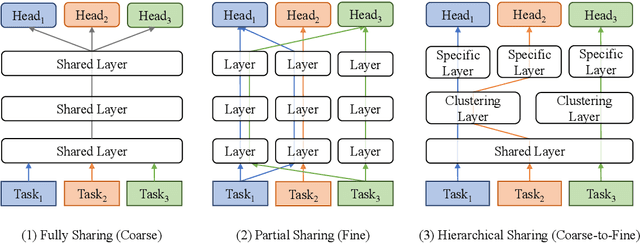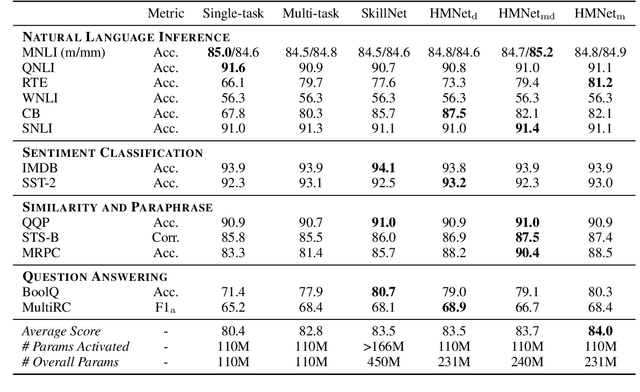Dejiang Kong
Coarse-to-Fine: Hierarchical Multi-task Learning for Natural Language Understanding
Aug 19, 2022



Abstract:Generalized text representations are the foundation of many natural language understanding tasks. To fully utilize the different corpus, it is inevitable that models need to understand the relevance among them. However, many methods ignore the relevance and adopt a single-channel model (a coarse paradigm) directly for all tasks, which lacks enough rationality and interpretation. In addition, some existing works learn downstream tasks by stitches skill block(a fine paradigm), which might cause irrationalresults due to its redundancy and noise. Inthis work, we first analyze the task correlation through three different perspectives, i.e., data property, manual design, and model-based relevance, based on which the similar tasks are grouped together. Then, we propose a hierarchical framework with a coarse-to-fine paradigm, with the bottom level shared to all the tasks, the mid-level divided to different groups, and the top-level assigned to each of the tasks. This allows our model to learn basic language properties from all tasks, boost performance on relevant tasks, and reduce the negative impact from irrelevant tasks. Our experiments on 13 benchmark datasets across five natural language understanding tasks demonstrate the superiority of our method.
VLDeformer: Learning Visual-Semantic Embeddings by Vision-Language Transformer Decomposing
Oct 20, 2021



Abstract:Vision-language transformers (VL transformers) have shown impressive accuracy in cross-modal retrieval. However, most of the existing VL transformers use early-interaction dataflow that computes a joint representation for the text-image input. In the retrieval stage, such models need to infer on all the matched text-image combinations, which causes high computing costs. The goal of this paper is to decompose the early-interaction dataflow inside the pre-trained VL transformer to achieve acceleration while maintaining its outstanding accuracy. To achieve this, we propose a novel Vision-language Transformer Decomposing (VLDeformer) to modify the VL transformer as an individual encoder for a single image or text through contrastive learning, which accelerates retrieval speed by thousands of times. Meanwhile, we propose to compose bi-modal hard negatives for the contrastive learning objective, which enables the VLDeformer to maintain the outstanding accuracy of the backbone VL transformer. Extensive experiments on COCO and Flickr30k datasets demonstrate the superior performance of the proposed method. Considering both effectiveness and efficiency, VLDeformer provides a superior selection for cross-modal retrieval in the similar pre-training datascale.
 Add to Chrome
Add to Chrome Add to Firefox
Add to Firefox Add to Edge
Add to Edge